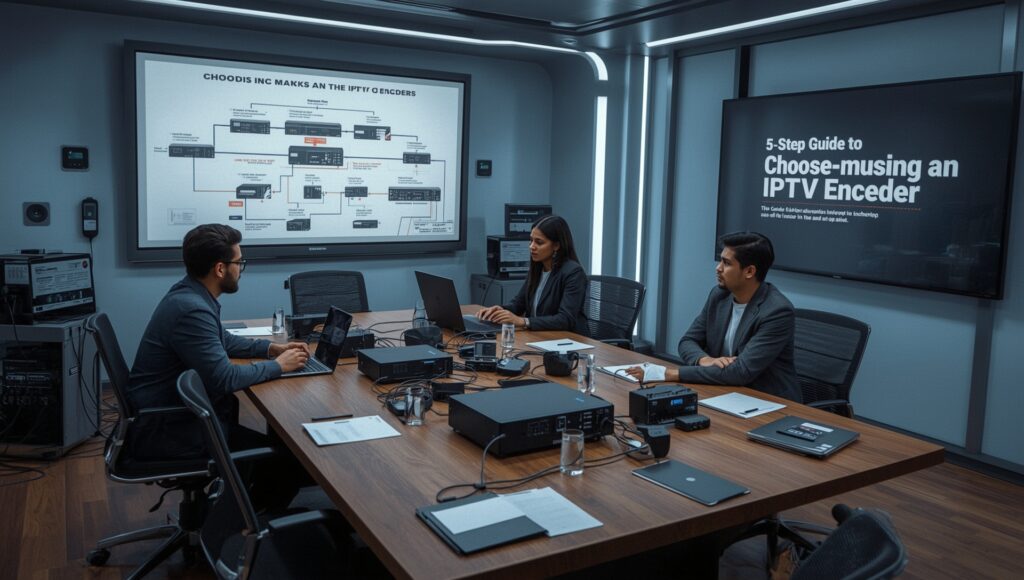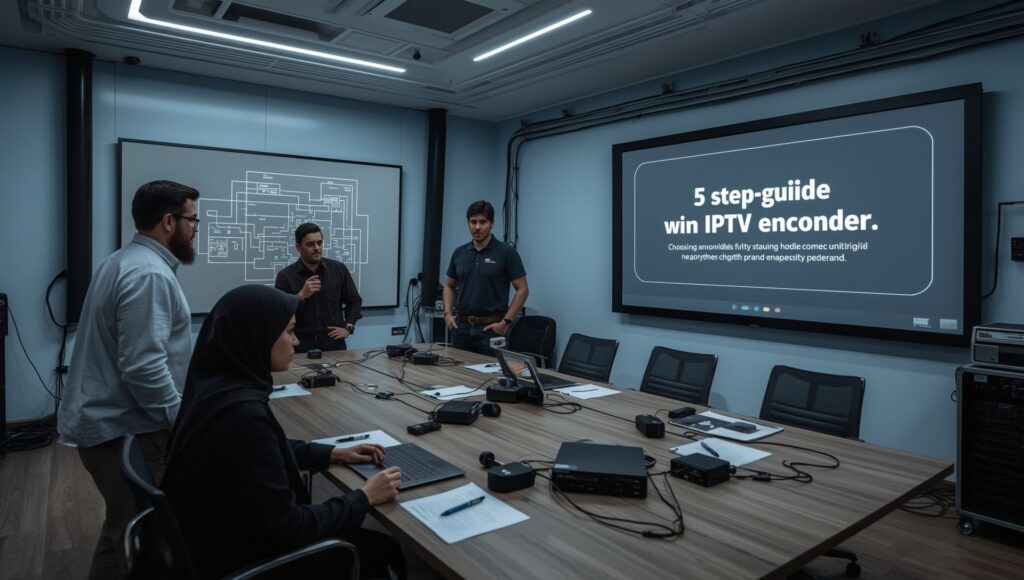Introduction: Understanding IPTV Encoders and Their Critical Role 🎯

In today’s rapidly evolving digital streaming landscape, IPTV encoders have become the backbone of professional broadcasting and streaming operations. An IPTV encoder is a specialized hardware or software device that converts analog or digital video signals into IP-based streams, enabling content delivery over internet protocols. These powerful tools transform raw video content into compressed, streamable formats that can reach audiences worldwide through IPTV networks.
The significance of choosing the right IPTV encoder cannot be overstated. Whether you’re a broadcaster launching a new streaming service, a content creator expanding your reach, or an organization implementing internal video distribution, your encoder selection directly impacts stream quality, viewer experience, and operational efficiency. With the global IPTV market projected to reach unprecedented heights, understanding how to select the perfect IPTV encoder has never been more crucial.
This comprehensive guide will walk you through five essential steps to make an informed IPTV encoder purchase, ensuring you invest in technology that meets your current needs while providing scalability for future growth. 🚀
Step 1: Assess Encoding Formats and Compression Standards 🔧
Understanding Core Video Codecs
The foundation of any IPTV encoder selection begins with understanding supported encoding formats. Modern IPTV encoders must support industry-standard codecs to ensure compatibility across various playback devices and streaming platforms.
Essential Encoding Formats to Consider:
• H.264 (AVC): The most widely supported codec, offering excellent compatibility across devices and platforms. Ideal for standard definition to 4K content delivery.
• H.265 (HEVC): Provides superior compression efficiency, reducing bandwidth requirements by up to 50% compared to H.264 while maintaining similar quality levels.
• AV1: The latest open-source codec offering exceptional compression for future-proof streaming solutions.
• MPEG-2: Legacy format still required for certain broadcasting applications and older infrastructure compatibility.
Audio Encoding Considerations
Beyond video compression, your IPTV encoder must handle multiple audio formats including AAC, MP3, and AC-3. Professional encoders should support multi-channel audio encoding for surround sound experiences and multiple language tracks for international content distribution.
Pro Tip: 💡 Choose encoders supporting adaptive bitrate encoding (ABR) to automatically adjust stream quality based on viewer connection speeds, ensuring optimal viewing experiences across various network conditions.

Step 2: Evaluate Input and Output Compatibility Requirements 📊
Input Interface Analysis
Your IPTV encoder’s input capabilities must align with your content sources. Professional broadcasting environments typically require multiple input options to accommodate diverse content feeds.
Critical Input Considerations:
• SDI Inputs: Professional broadcasters need 3G-SDI or 12G-SDI inputs for high-quality uncompressed video signals from cameras and production equipment.
• HDMI Inputs: Essential for connecting consumer devices, computers, and presentation equipment.
• IP Inputs: Network-based inputs for receiving streams from remote locations or other encoders.
• Analog Inputs: Legacy support for older equipment integration.
Output Protocol Support
Modern IPTV encoders must support various output protocols to ensure broad compatibility with streaming platforms and delivery networks.
Essential Output Protocols:
• RTMP/RTMPS: Required for streaming to platforms like YouTube Live, Facebook Live, and custom streaming servers.
• HLS (HTTP Live Streaming): Apple’s adaptive streaming protocol, essential for iOS device compatibility.
• DASH: Dynamic Adaptive Streaming over HTTP, providing universal compatibility across modern browsers and devices.
• UDP/RTP: Traditional broadcast protocols for IPTV headend integration.
Best Practice: 🎯 Ensure your chosen IPTV encoder supports simultaneous multi-protocol output, enabling content distribution across multiple platforms without additional hardware investments.
Step 3: Determine Bitrate and Resolution Support Needs 📈
Resolution Capability Assessment
Your IPTV encoder selection must accommodate current content resolution requirements while providing headroom for future upgrades. Consider your content sources and target audience viewing preferences when evaluating resolution support.
Resolution Categories to Consider:
• Standard Definition (480p): Suitable for legacy content and bandwidth-constrained environments.
• High Definition (720p/1080p): Industry standard for most streaming applications, offering excellent quality-to-bandwidth ratios.
• 4K Ultra HD (2160p): Premium content delivery requiring substantial encoding power and bandwidth capacity.
• 8K Ready: Future-proofing consideration for next-generation content delivery.
Bitrate Management Capabilities
Effective bitrate management directly impacts both stream quality and bandwidth costs. Professional IPTV encoders should offer granular bitrate control and intelligent rate adaptation features.
Key Bitrate Features:
• Variable Bitrate (VBR): Optimizes compression efficiency by allocating more bits to complex scenes while reducing bitrates during simple content segments.
• Constant Bitrate (CBR): Maintains consistent bandwidth usage, crucial for live streaming applications with strict network requirements.
• Multi-bitrate Encoding: Simultaneously creates multiple quality levels for adaptive streaming implementations.
Technical Consideration: ⚡ Calculate your total bandwidth requirements by multiplying maximum concurrent streams by highest bitrate settings, then add 20% overhead for network fluctuations and protocol requirements.
Step 4: Analyze Latency Requirements and Real-Time Performance 🚀
Understanding Latency Classifications
IPTV encoder latency directly affects viewer experience, particularly in interactive applications, live sports, and real-time communication scenarios. Understanding latency categories helps match encoder capabilities with application requirements.
Latency Classifications:
• Ultra-Low Latency (< 200ms): Required for interactive applications, live gaming, and real-time communication platforms.
• Low Latency (200ms – 2s): Suitable for live sports, news broadcasting, and interactive streaming where immediate response is important.
• Standard Latency (2s – 10s): Acceptable for general entertainment content and non-interactive streaming applications.
• High Latency (10s+): Primarily used for video-on-demand and pre-recorded content distribution.
Performance Optimization Features
Modern IPTV encoders incorporate various technologies to minimize latency while maintaining encoding quality. Evaluate these features based on your specific streaming requirements.
Latency Reduction Technologies:
• Hardware Acceleration: GPU-based encoding significantly reduces processing time compared to software-only solutions.
• Parallel Processing: Multi-core architectures enable simultaneous encoding of multiple streams without performance degradation.
• Adaptive Encoding: Real-time adjustment of encoding parameters based on content complexity and network conditions.
• Buffer Management: Intelligent buffering strategies that minimize delay while ensuring stream stability.
Professional Insight: 🔍 Test potential IPTV encoders under realistic network conditions, including packet loss and jitter scenarios, to verify claimed latency performance before making final purchasing decisions.
Step 5: Establish Budget Parameters and Total Cost of Ownership 💰
Initial Investment Categories
IPTV encoder pricing varies significantly based on features, performance, and target market. Understanding cost categories helps establish realistic budget expectations and identify the best value proposition for your requirements.
Price Range Classifications:
• Entry-Level ($500 – $2,000): Software encoders and basic hardware solutions suitable for small-scale streaming operations.
• Professional ($2,000 – $10,000): Feature-rich hardware encoders with advanced capabilities for commercial broadcasting applications.
• Enterprise ($10,000 – $50,000+): High-performance, rack-mounted solutions designed for large-scale broadcasting and streaming operations.
Ongoing Operational Costs
Beyond initial purchase price, consider ongoing costs that impact total cost of ownership throughout the encoder’s operational lifetime.
Operational Cost Considerations:
• Software Licensing: Annual fees for advanced features, codec updates, and technical support services.
• Bandwidth Costs: Monthly streaming bandwidth charges based on concurrent viewers and bitrate settings.
• Maintenance and Support: Professional support contracts, hardware warranties, and replacement component costs.
• Power Consumption: Electricity costs for 24/7 operation, particularly relevant for high-performance hardware encoders.
Return on Investment Analysis
Quantify the business impact of your IPTV encoder investment by analyzing revenue potential, cost savings, and operational efficiency improvements.
ROI Calculation Factors:
• Revenue Generation: Subscription fees, advertising revenue, and pay-per-view income enabled by streaming capabilities.
• Cost Reduction: Elimination of traditional broadcasting infrastructure, reduced content distribution costs, and operational efficiency gains.
• Scalability Benefits: Ability to expand audience reach without proportional infrastructure investments.
Financial Tip: 📊 Create a 3-year cost projection including all operational expenses to accurately compare different IPTV encoder options and identify the most cost-effective solution for your specific use case.
Best Practices for IPTV Encoder Selection 🏆
Performance Testing and Evaluation
Before finalizing your IPTV encoder purchase, implement thorough testing procedures to validate performance claims and ensure compatibility with your existing infrastructure.
Testing Checklist:
• Encode sample content across various resolutions and bitrates • Test all required input and output formats • Measure actual latency under realistic network conditions • Verify compatibility with target streaming platforms • Assess encoding quality using objective measurement tools
Vendor Support and Documentation
Reliable vendor support significantly impacts your long-term success with IPTV encoder implementation. Evaluate support quality, documentation completeness, and community resources before making your final decision.
Future-Proofing Considerations
Select IPTV encoders that accommodate technological evolution and business growth. Consider firmware update capabilities, expandable feature sets, and compatibility with emerging streaming standards.
Conclusion: Making Informed IPTV Encoder Decisions 🎯
Selecting the right IPTV encoder requires careful consideration of technical requirements, performance needs, and budget constraints. The five-step process outlined in this guide provides a systematic approach to evaluating options and making informed purchasing decisions.
Remember that the best IPTV encoder for your organization balances current requirements with future growth potential. Invest time in thorough evaluation, testing, and vendor research to ensure your chosen solution delivers optimal performance and value throughout its operational lifetime.
By following these guidelines and considering the specific needs of your streaming operation, you’ll be well-equipped to select an IPTV encoder that enhances your content delivery capabilities and supports your long-term broadcasting objectives. The investment in proper encoder selection today will pay dividends through improved stream quality, operational efficiency, and viewer satisfaction for years to come. 🚀
